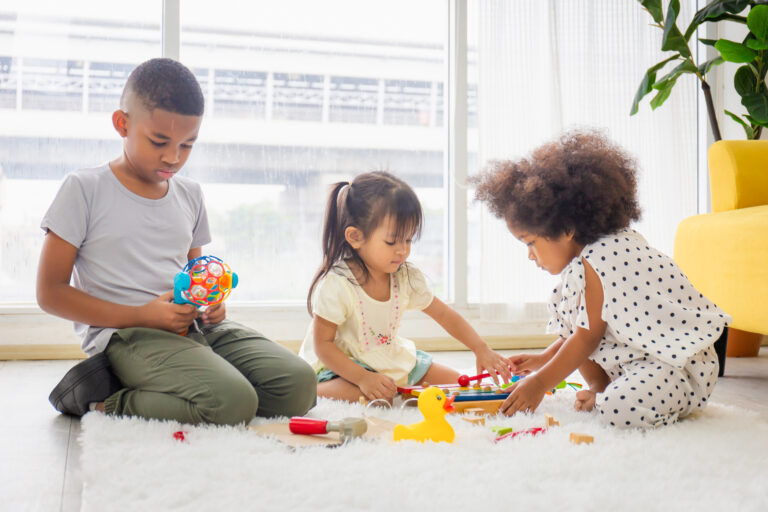In my journey through the vibrant world of early childhood education, I’ve had the unique pleasure of witnessing firsthand the miraculous ways in which children grow and learn.
From my first day working with children between 3 months and 5 years old, it became crystal clear: play is not just play. It’s the key to unlocking the boundless potential within each child.
Through my adventures and the many hats I’ve worn as an educator, I’ve discovered the profound impact that simple activities can have on boosting a child’s IQ.
The Role of Play in Child Development
In my years of working in childcare, I’ve found that play is the foundation upon which children build their understanding of the world.
It’s been my secret weapon in nurturing curious, intelligent, and well-rounded individuals. Play, in its many forms, is the natural way children learn to think, solve problems, and connect with those around them.
Cognitive Growth Through Exploration
From what I’ve experienced, exploration is the heart of learning during play.
When children are free to explore their environment, they’re doing much more than just playing; they’re conducting their first experiments with cause and effect, learning to predict outcomes, and developing critical thinking skills.
I’ve personally seen the joy on a child’s face when they discover something new—a look that says, “I understand this now!”
Language Development in Play Settings
Language is another area that flourishes through play. I’ve observed children narrating their actions, engaging in conversations with peers, or even talking to themselves during solitary play.
This verbalization is not just adorable chatter; it’s a crucial step in language development. I’ve tried incorporating storytime and role-playing games into daily activities, which has been a game-changer in enriching vocabulary and fostering communication skills.
Simple Activities That Make a Big Difference
Through my adventures with these young learners, I’ve gathered a treasure trove of simple activities that can significantly impact a child’s intellectual growth. Here’s a rundown of some of my go-to strategies:
Puzzle Time
Puzzles have been a staple in my toolkit. They’re fantastic for teaching problem-solving, enhancing spatial awareness, and improving hand-eye coordination. I’ve personally tested this technique across various age groups, starting with simple wooden puzzles for the little ones and gradually increasing complexity based on the child’s age and skill level.
Building Blocks
Whether it’s wooden blocks or interlocking plastic bricks, building activities stimulate creativity, planning, and engineering skills. I’ve seen children immersed in constructing elaborate structures, all the while honing their fine motor skills and learning the basics of physics without even realizing it.
Nature Walks
Taking the classroom outdoors has been one of my favorite strategies. Nature walks encourage observation, questioning, and the development of a keen eye for detail. From collecting leaves to watching ants, the natural world is a vast playground of learning opportunities.
Art and Craft
Art isn’t just about making things look pretty; it’s a powerful medium for expression and cognitive development. Through painting, drawing, and crafting, children learn about colors, shapes, and textures. I’ve found that open-ended art projects, where children are free to create as they wish, foster original thinking and innovation.
Music and Movement
Music has a special place in early education. Singing, dancing, and even simple rhythm games enhance memory, spatial reasoning, and coordination. I’ve tried integrating music and movement throughout the day and witnessed its incredible ability to boost mood, improve focus, and strengthen learning retention.
The Educator’s Role in Play
In my journey in childcare, I’ve learned that the role of the educator is pivotal in guiding play without overshadowing it. It’s about striking the right balance between providing structure and allowing freedom, offering new challenges and letting children discover their own solutions.
Creating an Enriching Environment
From what I’ve gathered, the environment we create speaks volumes. An enriching, well-thought-out space invites exploration and learning.
I’ve used thematic areas, rotating materials, and displays of children’s work to inspire curiosity and a sense of ownership over the learning process.
Being a Facilitator, Not a Director
I’ve seen the most profound growth in children when I’ve stepped back and allowed them to lead their play.
My role becomes that of a facilitator—observing, asking open-ended questions, and gently guiding when needed. This approach respects the child’s autonomy and encourages them to think critically and independently.
Final Thoughts
In my experience with children, the power of play in boosting a child’s IQ is undeniable. Simple activities, when approached with intention and understanding, can lay the foundation for lifelong learning and curiosity.
Through my years of working in early childhood education, I’ve come to see that every moment of play is a step towards building a brighter, more intelligent future for our children.
As educators and caregivers, our task is to provide the tools, the space, and the support for this magical process to unfold.
Let’s cherish these early years of exploration and discovery, knowing that we’re not just playing—we’re preparing the next generation of thinkers, innovators, and leaders.












